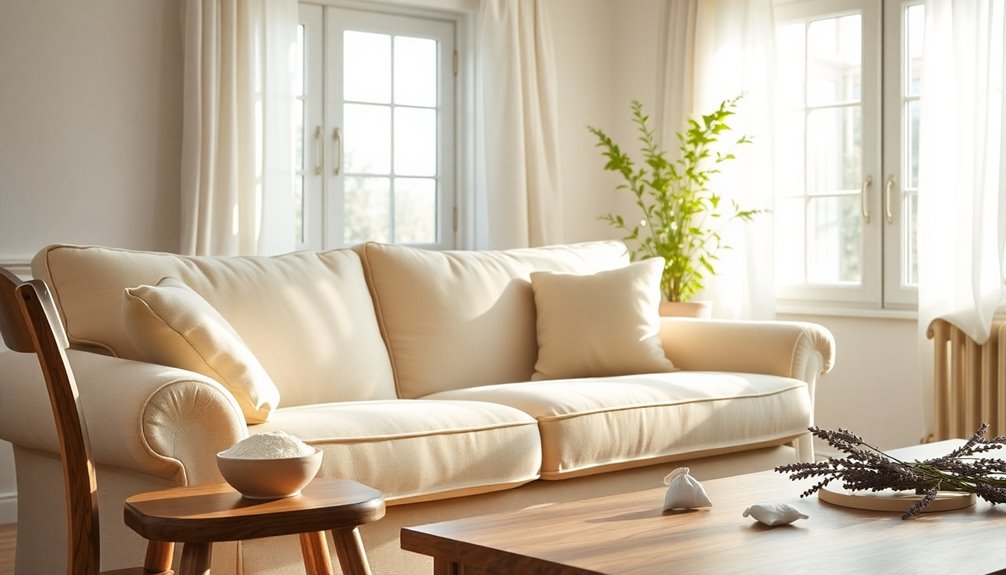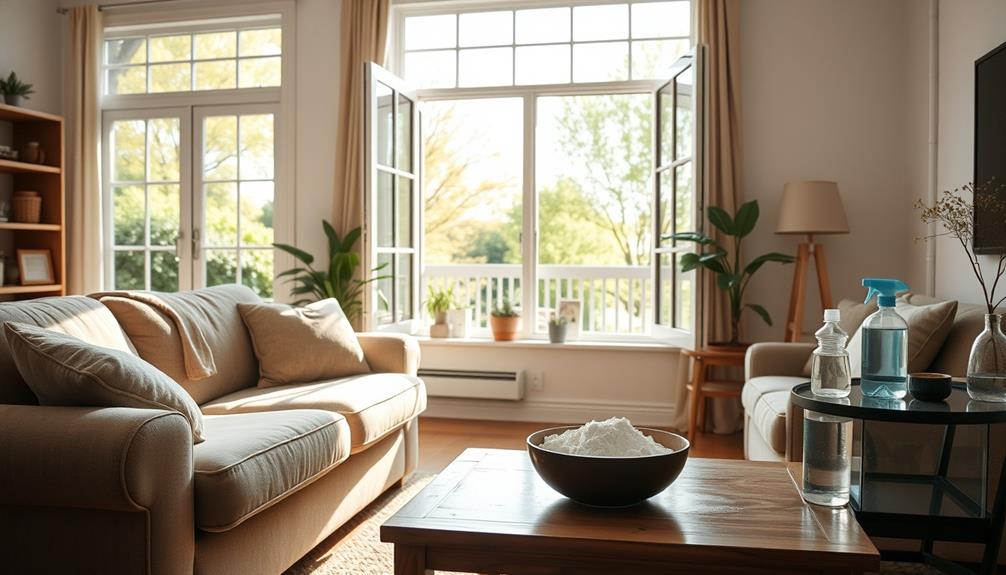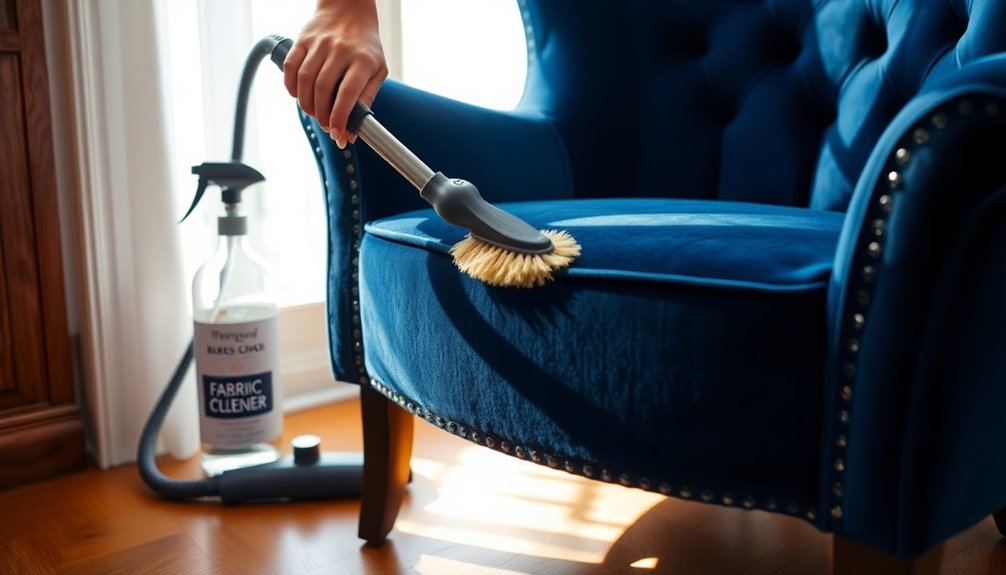To get musty smells out of your furniture, start by dusting surfaces with a soft cloth. Wipe down with a mild soap solution or a wood-safe cleaner. For a deeper clean, use a mixture of vinegar and water or a rubbing alcohol solution on fabric. Sprinkle baking soda generously and let it sit before vacuuming. Place activated charcoal or coffee grounds in your furniture to absorb odors. Finally, ensure good ventilation and expose your furniture to sunlight when possible. Keep going, and you'll discover more effective strategies to keep your furniture smelling fresh.
Key Takeaways
- Clean furniture surfaces with a mild soap solution and disinfect using a Pine-Sol and water mixture to eliminate odors effectively.
- Sprinkle baking soda on upholstered items, let it sit for several hours, then vacuum to absorb musty smells.
- Use activated charcoal or coffee grounds in trays placed inside furniture to absorb persistent odors over several days.
- Maintain indoor humidity levels between 40-50% with dehumidifiers to prevent mold growth and musty smells.
- Consider professional help if odors persist after cleaning, as it may indicate deeper issues like mold or structural damage.
Understanding Musty Smells
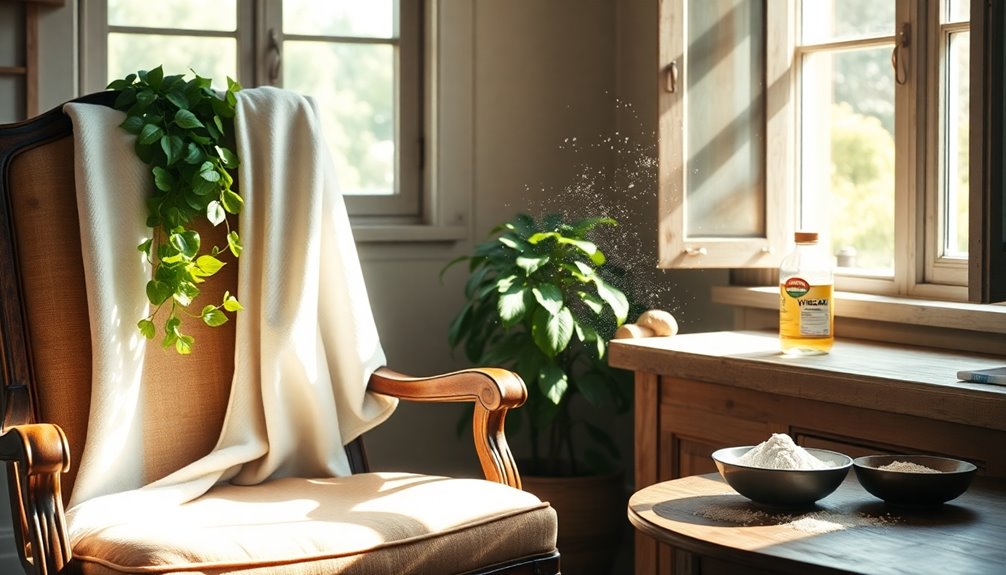
Musty smells in furniture often signal underlying issues that need addressing. One of the primary culprits is mold and mildew, which thrive in damp environments like basements or garages. When moisture seeps into your furniture, especially upholstered items, it can create a breeding ground for these fungi. Additionally, porous materials, such as wood, can absorb bacteria and germs, leading to those unpleasant odors.
Environmental factors also play a significant role. Your furniture can pick up smells from its surroundings, including pet odors, cigarette smoke, or even mothballs. High humidity levels exacerbate these issues, promoting mold and mildew growth. You might notice musty smells more often in older furniture, particularly if it's been stored in dark, damp places like attics or basements. Dehumidification can effectively remove odors by moving furniture to low-moisture areas, allowing the materials to breathe and dry out.
Lastly, enclosed spaces like drawers and compartments can trap musty odors, especially in poorly ventilated areas. Understanding these causes can help you identify potential problems and take action before the odors worsen. By recognizing these factors, you can better tackle musty smells and ensure your furniture remains fresh and inviting.
Using Natural Odor Absorbers
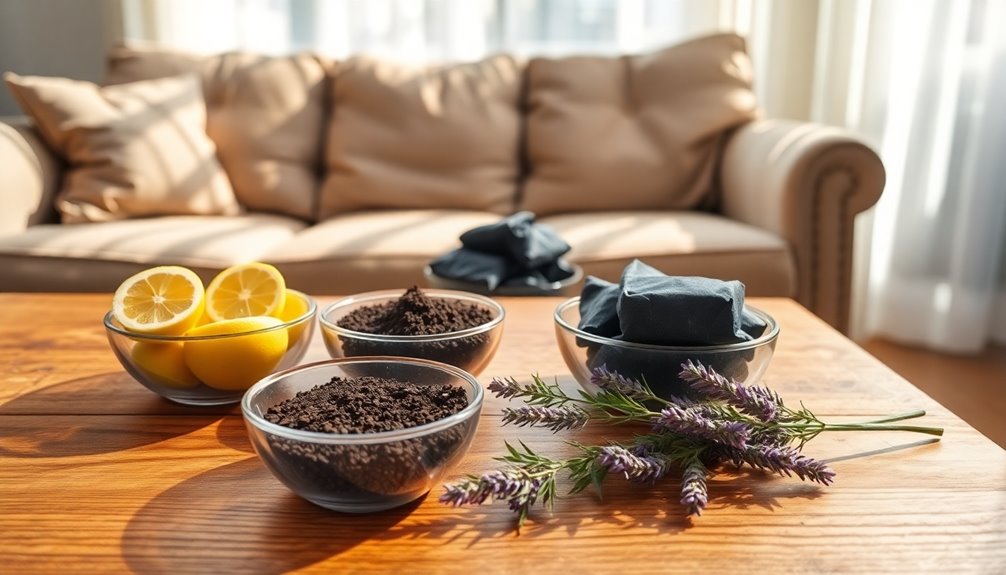
There are several effective natural odor absorbers you can use to eliminate musty smells from your furniture. One of the best options is activated charcoal, which is highly porous and absorbs odors efficiently. Simply place a bowl of activated charcoal inside the furniture and leave it for several days, replacing it as needed. Additionally, top-quality products remove unpleasant smells from smoke, sweat, food, and pets.
Vinegar is another great choice. Mix equal parts of water and white vinegar in a spray bottle, then lightly mist the furniture. You can also wipe down surfaces and drawers with a vinegar-soaked washcloth to tackle stubborn odors. Vinegar works by breaking down acidic and alkaline particles responsible for musty smells.
Baking soda is a powerful, eco-friendly solution. Sprinkle it generously on the affected areas and let it sit for a few hours or overnight before vacuuming it up.
Additionally, coffee grounds can also absorb musty odors effectively. Spread them in a tray or bowl and place them inside the furniture. Lastly, don't underestimate the power of sunlight—natural light can help dry out porous wood and eliminate lingering musty smells.
Cleaning and Disinfecting Furniture
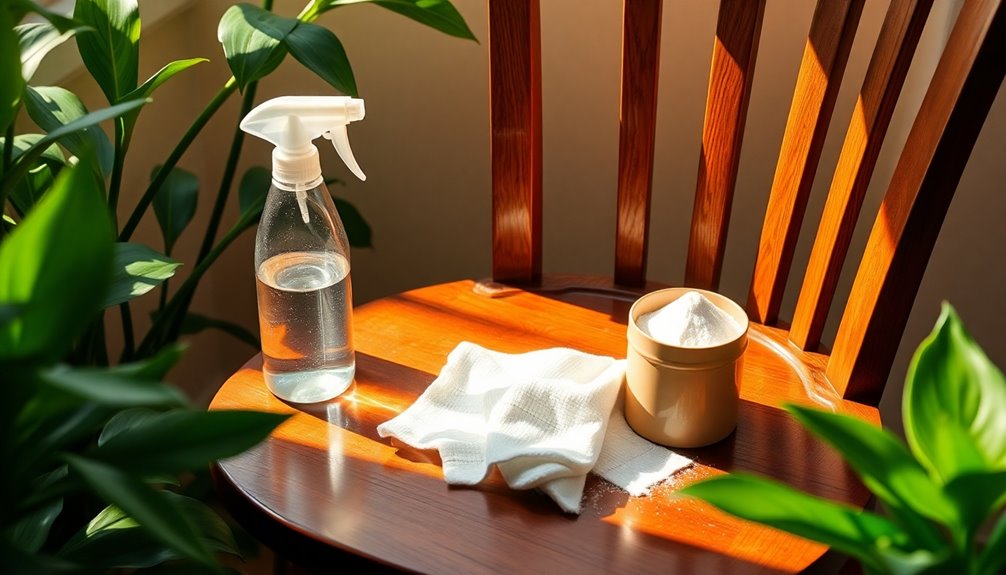
After using natural odor absorbers to tackle musty smells, it's important to clean and disinfect your furniture to eliminate any remaining odors and maintain its condition. Start by dusting the surfaces with a soft, dry cloth or a feather duster. Then, dampen a clean cloth with a mild soap solution or a wood-safe cleaner, avoiding harsh chemicals that could damage the finish. Gently wipe down the furniture, following the grain of the wood, and ensure the cloth is just damp to prevent excess moisture.
For disinfecting, mix 1 cup of Pine-Sol with ½ gallon of water, allowing it to sit for ten minutes. Use this solution sparingly to avoid saturating the wood, as Pine-Sol provides 5x cleaning action against odor, grease, grime, dirt, and allergens. If you're dealing with fabric couches, a mix of 2 cups rubbing alcohol and 1 cup water works well. For leather or fabric surfaces, a white vinegar and water solution can also disinfect effectively.
After cleaning, dry the surfaces with a clean cloth to remove any remaining moisture. Regular cleaning and disinfecting not only help eliminate musty odors but also prevent the buildup of germs, ensuring your furniture stays in great condition.
Utilizing Sunlight and Ventilation
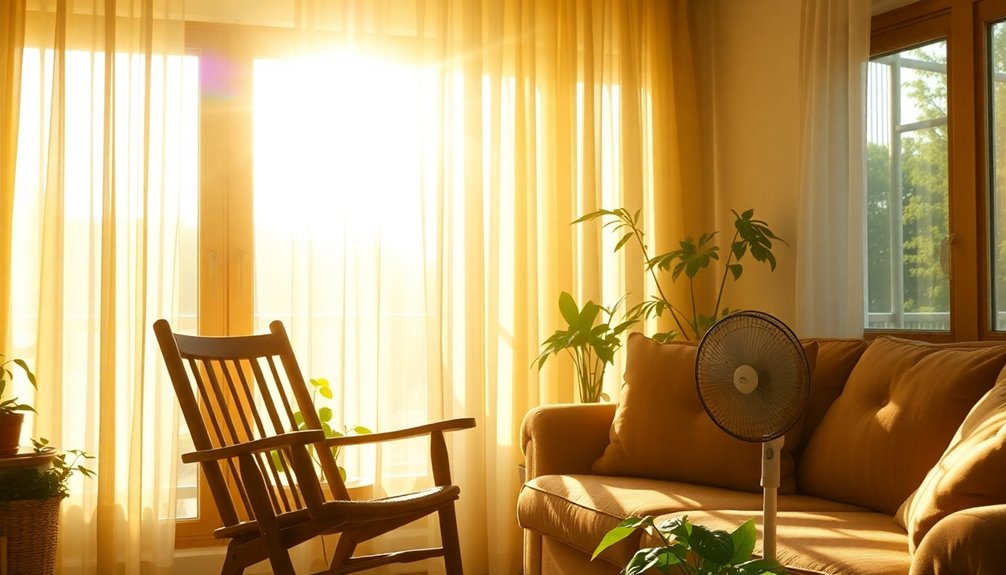
Sunlight and ventilation can be your best allies in eliminating musty smells from furniture. Start by placing your furniture outdoors in direct sunlight for a few hours. The UV rays help break down odor-causing compounds and act as a natural disinfectant, killing bacteria that contribute to those unpleasant odors. Just be cautious with delicate or antique pieces to avoid sun damage. If direct sunlight isn't an option, consider letting the furniture air out under a covered porch.
While sunlight works wonders, don't forget about ventilation. Open windows regularly to let in fresh air and improve circulation. Use exhaust fans in kitchens and bathrooms to reduce humidity, which can lead to musty smells. Proper airflow helps dry out your furniture after cleaning, preventing moisture buildup. Additionally, mold growth can be significantly reduced by ensuring good ventilation throughout your home.
To maximize the effects, use fans around the furniture while it's in the sunlight. After cleaning, move the furniture to a well-ventilated area to speed up the drying process. You can also combine sunlight exposure with a dehumidifier for better results. Maintaining optimal indoor humidity levels is vital to prevent the return of musty odors.
Refinishing and Sealing Techniques
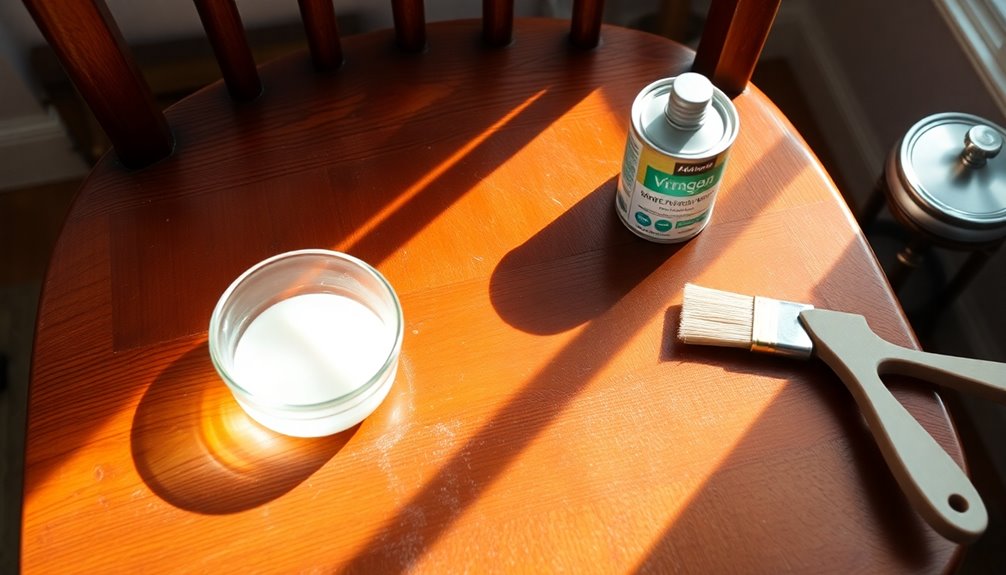
Refinishing and sealing your furniture can effectively eliminate musty odors while revitalizing its appearance. Start by identifying the type of wood and its current finish to choose the right stripping and refinishing methods. If you have solid wood or wood veneer, remember that they require different approaches. Assess the age and condition of your furniture to determine the best refinishing technique. Engaging in refinishing projects not only enhances the aesthetics of your furniture but also fosters a sense of community through shared experiences.
Next, strip the old finish using chemical strippers or power sanders. Apply chemical strippers evenly with a bristle brush, following the manufacturer's instructions. Once the finish is removed, sand the surface starting with coarse grit sandpaper, then progress to finer grits for a smooth finish.
Now, apply a new finish, selecting from options like oil finishes or polyurethane varnish. For durability, especially on coffee or dining tables, polyurethane is ideal. Be sure to apply in thin layers, allowing each coat to dry completely before adding the next.
Finally, maintain your newly refinished furniture by regularly cleaning it with a mild wood cleaner. This will help keep odors at bay and preserve the fresh look of your furniture for years to come.
Advanced Cleaning Methods
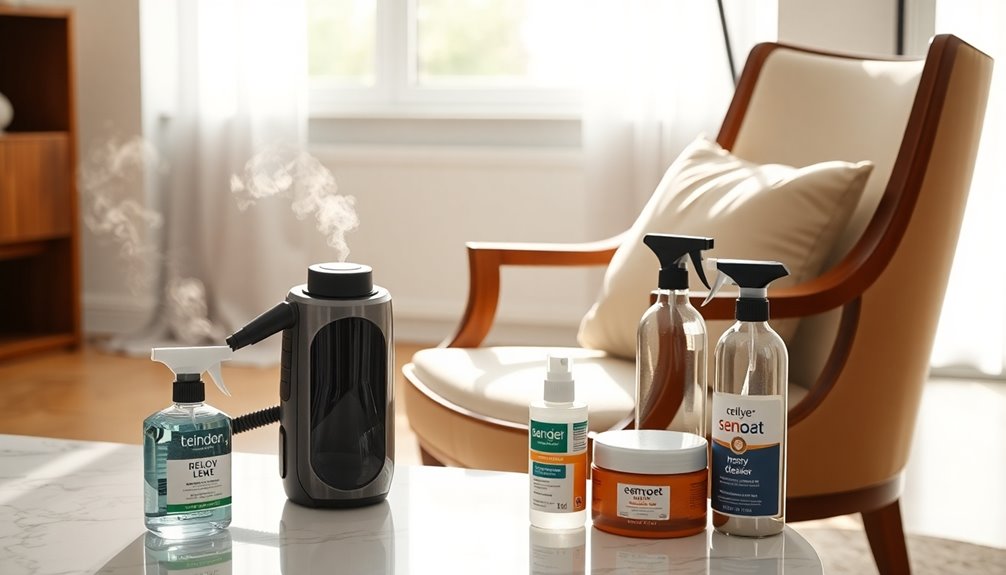
When dealing with musty smells in furniture, advanced cleaning methods can make a significant difference. Start by cleaning and disinfecting your furniture. Mix a 50/50 solution of rubbing alcohol and water, and spray it on surfaces to kill odor-causing bacteria. Wipe everything down, including drawers, with a vinegar and water solution. For deeper cleaning, use Murphy's Oil Soap or anti-fungal detergents inside the drawers. Regular professional cleaning can enhance the effectiveness of these methods.
To absorb lingering odors, place bowls of vinegar, charcoal, or baking soda in the drawers for several days. You can also use kitty litter or vodka as alternatives. Sprinkle baking soda generously, let it sit, and vacuum it out later. Mold exposure can lead to intense sinus and facial pain, highlighting the importance of thorough cleaning to avoid health risks.
Next, expose your furniture to direct sunlight to help dry it out and eliminate musty smells, especially if it was stored in a damp area. If you have a dehumidifier, use it in a small room to reduce moisture and odors.
Lastly, consider applying chemical odor blockers like OdoBan or specialized wood deodorizers to further combat the smell. With these advanced methods, you'll effectively revive your furniture and enjoy a fresher space.
Preventative Measures
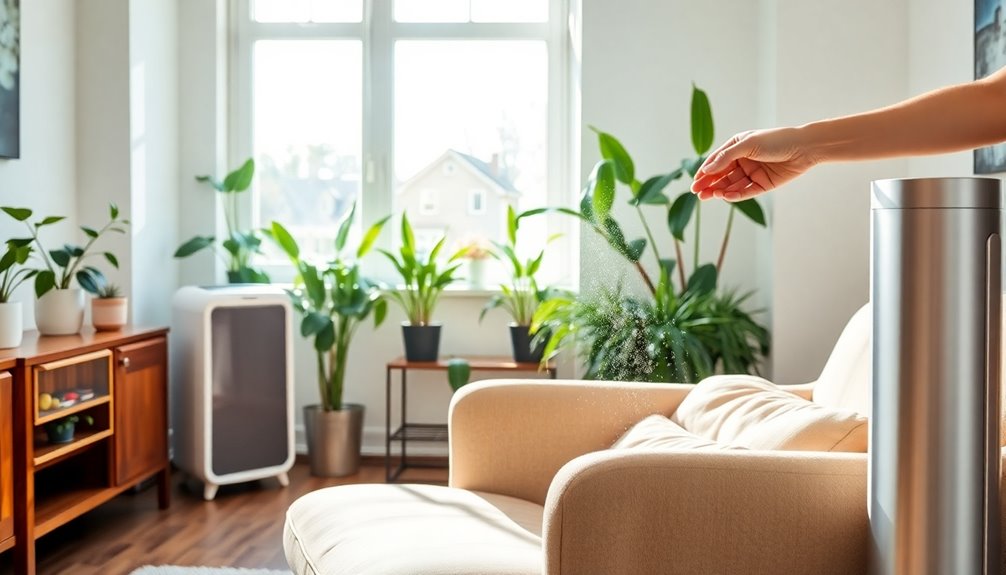
Preventing musty smells in your furniture starts with effective humidity control. Keep indoor humidity levels between 40-50% by using dehumidifiers, especially during rainy or humid seasons. Invest in an air conditioning system if necessary, and monitor humidity levels with indicators. Place moisture absorbers like silica gel in closed spaces to combat excess moisture. Ensure good ventilation by using fans or opening windows regularly. Regularly checking for leaks or cracks in your home can further enhance your humidity control efforts.
When it comes to furniture placement, keep your pieces away from kitchens, bathrooms, and other damp areas. Avoid storing furniture in basements due to high moisture levels. If you need to store items long-term, opt for climate-controlled storage units. Leave at least 6 inches of space between your furniture and walls to promote air circulation, and consider using waterproof furniture covers for added protection.
Regular maintenance is also vital. Dust and clean your furniture often to prevent moisture buildup. Vacuum upholstered items weekly, and wipe down leather surfaces. Address any pet accidents immediately to avoid lingering odors. Lastly, use dry fabrics instead of wet cloths for cleaning, ensuring your furniture remains fresh and musty-free.
When to Seek Professional Help
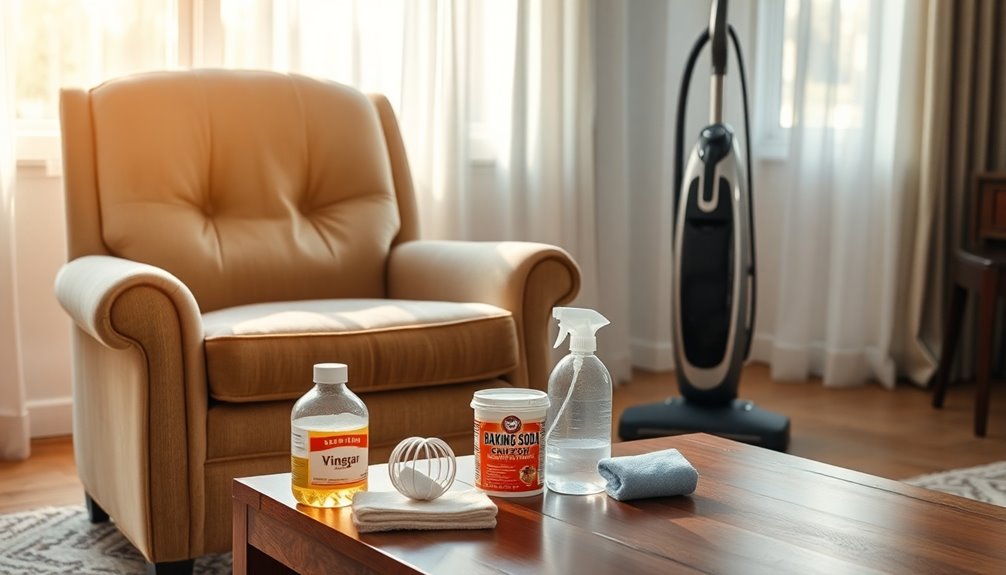
Noticing a persistent musty smell in your furniture despite your best DIY efforts can be frustrating. If you've tried various methods without success, it might signal a deeper issue, like extensive mold or mildew growth that needs professional treatment. Professionals have access to powerful chemicals and equipment that can effectively eliminate stubborn odors. They can also identify any underlying moisture problems contributing to the smell.
If you observe signs of structural damage, like cracks or rotting wood, don't hesitate to seek help. Structural damage can compromise the integrity of your furniture, and professionals can assess the situation and recommend appropriate repairs or restorations. High humidity levels contribute significantly to the development of musty odors, making it crucial to address these conditions during professional evaluations.
Specialized materials, such as antique wood or leather, often require expert care. Professionals know how to clean and restore these materials without causing damage. In cases of water damage or extensive mold, professional intervention is crucial. They can thoroughly dry out the furniture and apply antifungal treatments to prevent further issues.
Ignoring these signs can lead to more significant problems, so when in doubt, it's best to consult the experts. Your furniture deserves the right care to restore its beauty and safety.
Maintaining a Fresh Environment
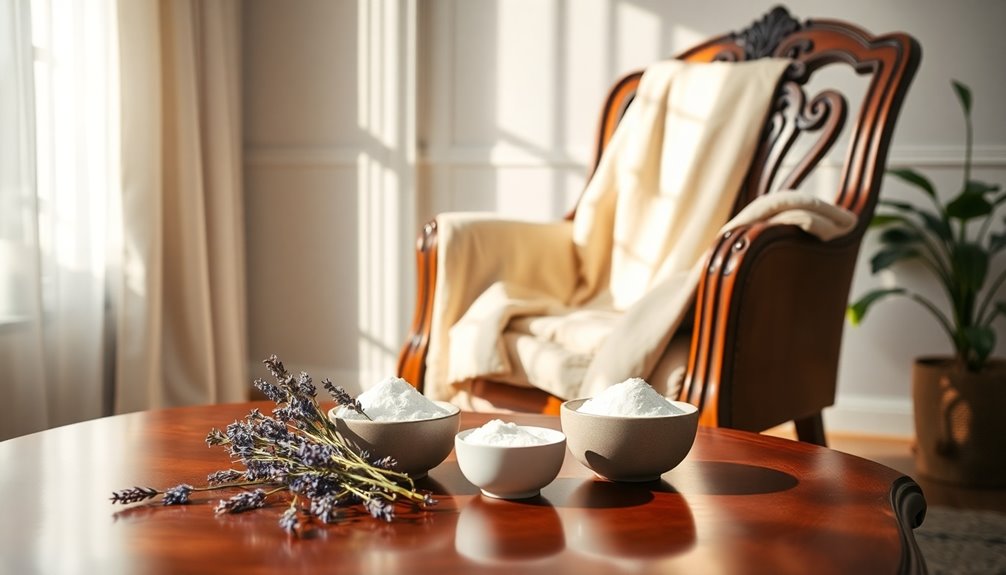
To keep your furniture smelling fresh, regular maintenance is essential. Start by vacuuming upholstered furniture weekly to prevent dust and debris from building up. Wipe down wooden surfaces often to remove dirt and dust, and don’t forget the insides and outsides of drawers. Use a damp cloth with a vinegar and water solution to clean the entire piece, ensuring you reach areas where wood meets air. Additionally, consider using baking soda as a versatile odor absorber by sprinkling it on affected areas and letting it sit for several hours. Regularly monitor indoor humidity levels to prevent mold growth that can contribute to musty odors. To further enhance the freshness of your furniture, it’s crucial to understand how to maintain dustfree furniture. Consider using an air purifier to help reduce airborne particles and allergens that can settle on your surfaces. Additionally, make it a habit to declutter regularly, as fewer items mean less dust accumulation, making your cleaning efforts more effective in the long run.
For upholstered furniture, consider using fabric protectors or sprays to repel stains and odors. If you have pets, invest in furniture with removable, washable covers for easier cleanups. Regularly apply multi-purpose cleaners to sanitize both wood and fabric surfaces, and utilize upholstery sprays to eliminate odors as recommended by the manufacturer.
Proper ventilation is crucial, so open your windows regularly to encourage airflow. Use exhaust fans in kitchens and bathrooms to reduce moisture buildup. Air purifiers can help maintain clean indoor air, and placing furniture in well-ventilated areas prevents moisture accumulation. Additionally, keep an eye on indoor humidity levels and use dehumidifiers in damp spaces to further combat musty smells. Operating air purifiers during high pollution days can also enhance air quality and reduce odors.
Frequently Asked Questions
Can Musty Smells Be Removed Permanently From Furniture?
Yes, you can remove musty smells from furniture permanently with the right approach. Start by thoroughly cleaning the piece, using vinegar or wood soap to eliminate odors. Then, ensure it's in a well-ventilated area or expose it to sunlight. Consider using odor absorbers like baking soda or charcoal. Refinishing the wood can also help trap any remaining odors. Regular maintenance, like vacuuming and wiping surfaces, will keep your furniture fresh long-term.
What Types of Wood Are Most Prone to Musty Odors?
If you're wondering which types of wood are most prone to musty odors, softwoods like pine, fir, spruce, and cedar top the list. These woods contain high levels of terpenes, which contribute to their strong scents. Hardwoods like oak and walnut can also develop musty smells under certain conditions, especially if exposed to moisture. Storing wood in damp areas increases the likelihood of musty odors, so keep that in mind when choosing wood for your projects.
How Can I Tell if My Furniture Has Mold?
To tell if your furniture has mold, look for visible signs like discoloration or fuzzy patches. Check for a musty odor, which often indicates mold presence. Inspect hidden areas, such as under cushions or inside drawers, where mold might lurk. If you notice water damage, such as stains or warping, it's another red flag. Regularly checking these areas can help you catch mold early before it spreads.
Are There Specific Essential Oils That Help Eliminate Musty Smells?
Yes, there are several essential oils that can help eliminate musty smells. You'll find lemon, tea tree, and eucalyptus essential oils particularly effective due to their antimicrobial properties. Mixing these oils with water creates a powerful odor-eliminating spray. You can also diffuse them in your space or apply them directly to surfaces. Combining essential oils with other methods, like sunlight or absorbent materials, can further enhance their effectiveness in removing unwanted odors.
How Often Should I Clean My Furniture to Prevent Musty Odors?
You should clean your furniture regularly to prevent musty odors. For high-traffic areas or homes with pets and kids, aim for every 6-12 months. If your furniture has delicate fabrics, consider more frequent professional cleaning. Regularly vacuum and spot clean to maintain freshness between deep cleans. Don't forget to control humidity and ensure good ventilation in your rooms. Following these guidelines will help keep your furniture smelling fresh and clean.
Conclusion
In conclusion, tackling musty smells in your furniture requires a mix of cleaning, natural remedies, and preventative measures. By using odor absorbers, ensuring proper ventilation, and considering refinishing techniques, you can effectively restore freshness to your pieces. Don't forget to maintain a clean environment to prevent future odors. If the smell persists despite your efforts, it might be time to call in the professionals. With these tips, you'll enjoy a fresher living space in no time!
